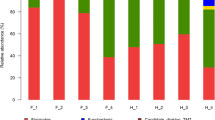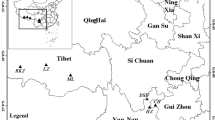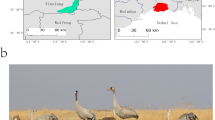Abstract
The gastrointestinal microbiota, a complex ecosystem, is involved in the physiological activities of hosts and the development of diseases. Birds occupy a critical ecological niche in the ecosystem, performing a variety of ecological functions and possessing a complex gut microbiota composition. However, the gut microbiota of wild and captive birds has received less attention in the same region. We profiled the fecal gut microbiome of wild wintering whooper swans (Cygnus Cygnus; Cyg group, n = 25), captive black swans (Cygnus Atratus; Atr group, n = 20), and mute swans (Cygnus Olor; Olor group, n = 30) using 16S rRNA gene sequencing to reveal differences in the gut microbial ecology. The results revealed that the three species of swans differed significantly in terms of the alpha and beta diversity of their gut microbiota, as measured by ACE, Chao1, Simpson and Shannon indices, principal coordinates analysis (PCoA) and non-metricmulti-dimensional scaling (NMDS) respectively. Based on the results of the linear discriminant analysis effect size (LEfSe) and random forest analysis, we found that there were substantial differences in the relative abundance of Gottschalkia, Trichococcus, Enterococcus, and Kurthia among the three groups. Furthermore, an advantageous pattern of interactions between microorganisms was shown by the association network analysis. Among these, Gottschalkia had the higher area under curve (AUC), which was 0.939 (CI = 0.879–0.999), indicating that it might be used as a biomarker to distinguish between wild and captive black swans. Additionally, PICRUSt2 predictions indicated significant differences in gut microbiota functions between wild and captive trumpeter swans, with the gut microbiota functions of Cyg group focusing on carbohydrate metabolism, membrane transport, cofactor, and vitamin metabolism pathways, the Atr group on lipid metabolism, and the Olor group on cell motility, amino acid metabolism, and replication and repair pathways. These findings showed that the gut microbiota of wild and captive swans differed, which is beneficial to understand the gut microecology of swans and to improve regional wildlife conservation strategies.








Similar content being viewed by others
Data availability
The sequencing data generated in our study have been deposited in the SRA database and the BioProject ID is PRJNA921745.
References
Barbosa A, Balagué V, Valera F, Martínez A, Benzal J, Motas M, Diaz JI, Mira A, Pedrós-Alió C (2016) Age-related differences in the gastrointestinal microbiota of chinstrap penguins (Pygoscelis antarctica). PLoS One 11:e0153215. https://doi.org/10.1371/journal.pone.0153215
Bodawatta KH, Hird SM, Grond K, Poulsen M, Jønsson KA (2022) Avian gut microbiomes taking flight. Trends Microbiol 30:268–280. https://doi.org/10.1016/j.tim.2021.07.003
Cabrera-Mulero A, Tinahones A, Bandera B, Moreno-Indias I, Macías-González M, Tinahones FJ (2019) Keto microbiota: a powerful contributor to host disease recovery. Rev Endocr Metab Disord 20:415–425. https://doi.org/10.1007/s11154-019-09518-8
Chi L, Tu P, Ru H, Lu K (2021) Studies of xenobiotic-induced gut microbiota dysbiosis: from correlation to mechanisms. Gut Microbes 13:1921912. https://doi.org/10.1080/19490976.2021.1921912
Cho H, Lee WY (2020) Interspecific comparison of the fecal microbiota structure in three Arctic migratory bird species. Ecol Evol 10:5582–5594. https://doi.org/10.1002/ece3.6299
Chung DM, Ferree E, Simon DM, Yeh PJ (2018) Patterns of bird-bacteria associations. Ecohealth 15:627–641. https://doi.org/10.1007/s10393-018-1342-5
Ge Y, Jing Z, Diao Q, He JZ, Liu YJ (2021) Host species and geography differentiate honeybee gut bacterial communities by changing the relative contribution of community assembly processes. mBio 12:e0075121. https://doi.org/10.1128/mBio.00751-21
Grond K, Sandercock BK, Jumpponen A, Zeglin LH (2018) The avian gut microbiota: community, physiology and function in wild birds. J Avian Biol 49:e01788
Grond K, Santo Domingo JW, Lanctot RB, Jumpponen A, Bentzen RL, Boldenow ML, Brown SC, Casler B, Cunningham JA, Doll AC, Freeman S, Hill BL, Kendall SJ, Kwon E, Liebezeit JR, Pirie-Dominix L, Rausch J, Sandercock BK (2019) Composition and drivers of gut microbial communities in arctic-breeding shorebirds. Front Microbiol 10:2258. https://doi.org/10.3389/fmicb.2019.02258
Hamilton AL, Kamm MA, Ng SC, Morrison M (2018) Proteus spp. as putative gastrointestinal pathogens. Clin Microbiol Rev 31:e00085–e00017. https://doi.org/10.1128/CMR.00085-17
Hird SM, Carstens BC, Cardiff SW, Dittmann DL, Brumfield RT (2014) Sampling locality is more detectable than taxonomy or ecology in the gut microbiota of the brood-parasitic Brown-headed Cowbird (Molothrus ater). PeerJ 2:e321. https://doi.org/10.7717/peerj.321
Jin Y, Lu L, Tu W, Luo T, Fu Z (2019) Impacts of polystyrene microplastic on the gut barrier, microbiota and metabolism of mice. Sci Total Environ 649:308–317. https://doi.org/10.1016/j.scitotenv.2018.08.353
Lewis WB, Moore FR, Wang S (2016) Characterization of the gut microbiota of migratory passerines during stopover along the northern coast of the Gulf of Mexico. J Avian Biol 47:659–668
Lewis WB, Moore FR, Wang S (2017) Changes in gut microbiota of migratory passerines during stopover after crossing an ecological barrier. Auk: Ornithological Adv 134:137–145
Li C, Liu Y, Gong M, Zheng C, Zhang C, Li H, Wen W, Wang Y, Liu G (2021) Diet-induced microbiome shifts of sympatric overwintering birds. Appl Microbiol Biotechnol 105:5993–6005. https://doi.org/10.1007/s00253-021-11448-y
Li S, Meng W, Liu D, Yang Q, Chen L, Dai Q, Ma T, Gao R, Ru W, Li Y, Yu P, Lu J, Zhang G, Tian H, Chai H, Li Y (2018) Migratory whooper swans cygnus cygnus transmit H5N1 virus between China and Mongolia: combination evidence from satellite tracking and phylogenetics analysis. Sci Rep 8:7049. https://doi.org/10.1038/s41598-018-25291-1
Liu G, Li C, Liu Y, Zheng CM, Ning Y, Yang HG, Suo L, Qi XZ, Li HX, Wen WY, Wang YH, Qi HY, Cai P, Gong MH (2022) Highland adaptation of birds on the Qinghai-Tibet Plateau via gut microbiota. Appl Microbiol Biotechnol 106:6701–6711. https://doi.org/10.1007/s00253-022-12171-y
Liu G, Meng D, Gong M, Li H, Wen W, Wang Y, Zhou J (2020) Effects of sex and diet on gut microbiota of farmland-dependent wintering birds. Front Microbiol 11:587873. https://doi.org/10.3389/fmicb.2020.587873
Maurice CF, Knowles SC, Ladau J, Pollard KS, Fenton A, Pedersen AB, Turnbaugh PJ (2015) Marked seasonal variation in the wild mouse gut microbiota. ISME J 9:2423–2434. https://doi.org/10.1038/ismej.2015.53
McFall-Ngai M, Hadfield MG, Bosch TC, Carey HV, Domazet-Lošo T, Douglas AE, Dubilier N, Eberl G, Fukami T, Gilbert SF, Hentschel U, King N, Kjelleberg S, Knoll AH, Kremer N, Mazmanian SK, Metcalf JL, Nealson K, Pierce NE et al (2013) Animals in a bacterial world, a new imperative for the life sciences. Proc Natl Acad Sci U S A 110:3229–3236. https://doi.org/10.1073/pnas.1218525110
Megrian D, Taib N, Witwinowski J, Beloin C, Gribaldo S (2020) One or two membranes? Diderm Firmicutes challenge the Gram-positive/Gram-negative divide. Mol Microbiol 113:659–671. https://doi.org/10.1111/mmi.14469
Nyaoke AC, Navarro MA, Fresneda K, Diab SS, Moore J, Lyras D, Awad M, Uzal FA (2020) Paeniclostridium (Clostridium) sordellii-associated enterocolitis in 7 horses. J Vet Diagn Invest 32:239–245. https://doi.org/10.1177/1040638720903738
Palinauskas V, Mateos-Hernandez L, Wu-Chuang A, de la Fuente J, Aželytė J, Obregon D, Cabezas-Cruz A (2022) Exploring the ecological implications of microbiota diversity in birds: natural barriers against avian malaria. Front Immunol 13:807682. https://doi.org/10.3389/fimmu.2022.807682
Poehlein A, Yutin N, Daniel R, Galperin MY (2017) Proposal for the reclassification of obligately purine-fermenting bacteria Clostridium acidurici (Barker 1938) and Clostridium purinilyticum (Dürre et al. 1981) as Gottschalkia acidurici gen. nov. comb. nov. and Gottschalkiapurinilytica comb. nov. and of Eubacterium angustum (Beuscher and Andreesen 1985) as Andreesenia angusta gen. nov. comb. nov. in the family Gottschalkiaceae fam. nov. Int J Syst Evol Microbiol 67:2711–2719. https://doi.org/10.1099/ijsem.0.002008
Rasidi EK, Cornejo J (2021) Managing the health of captive flocks of birds. Vet Clin North Am Exot Anim Pract 24:521–530. https://doi.org/10.1016/j.cvex.2021.05.004
Teyssier A, Matthysen E, Hudin NS, de Neve L, White J, Lens L (2020) Diet contributes to urban-induced alterations in gut microbiota: experimental evidence from a wild passerine. Proc Biol Sci 287:20192182. https://doi.org/10.1098/rspb.2019.2182 Epub 2020 Feb 5
Turjeman S, Corl A, Wolfenden A, Tsalyuk M, Lublin A, Choi O, Kamath PL, Getz WM, Bowie RCK, Nathan R (2020) Migration, pathogens and the avian microbiome: a comparative study in sympatric migrants and residents. Mol Ecol 29:4706–4720. https://doi.org/10.1111/mec.15660
Wang B, Zhong H, Liu Y, Ruan L, Kong Z, Mou X, Wu L (2022) Diet drives the gut microbiome composition and assembly processes in winter migratory birds in the Poyang Lake wetland China. Front Microbiol 13:973469. https://doi.org/10.3389/fmicb.2022.973469
Wang W, Huang S, Yang L, Zhang G (2021) Comparative analysis of the fecal bacterial microbiota of wintering whooper swans (Cygnus Cygnus). Front Vet Sci 8:670645. https://doi.org/10.3389/fvets.2021.670645
Wang W, Wang A, Yang Y, Wang F, Liu Y, Zhang Y, Sharshov K, Gui L (2019) Composition, diversity and function of gastrointestinal microbiota in wild red-billed choughs (Pyrrhocorax pyrrhocorax). Int Microbiol 22:491–500. https://doi.org/10.1007/s10123-019-00076-2
Wang W, Zheng S, Sharshov K, Sun H, Yang F, Wang X, Li L, Xiao Z (2017) Metagenomic profiling of gut microbial communities in both wild and artificially reared Bar-headed goose (Anser indicus). Microbiologyopen 6:e00429. https://doi.org/10.1002/mbo3.429 Epub 2016 Dec 20
Wu J, Wang K, Wang X, Pang Y, Jiang C (2021) The role of the gut microbiome and its metabolites in metabolic diseases. Protein Cell 12:360–373. https://doi.org/10.1007/s13238-020-00814-7
Wu X, Wei Q, Wang X, Shang Y, Zhang H (2022) Evolutionary and dietary relationships of wild mammals based on the gut microbiome. Gene 808:145999. https://doi.org/10.1016/j.gene.2021.145999
Xiao K, Fan Y, Zhang Z, Shen X, Li X, Liang X, Bi R, Wu Y, Zhai J, Dai J, Irwin DM, Chen W, Shen Y (2021) Covariation of the fecal microbiome with diet in nonpasserine birds. mSphere 6:e00308–e00321. https://doi.org/10.1128/mSphere.00308-21
Xu TT, Chen P, Zhang CD, Shaukat A, Lin LX, Yue K, Ding WL, Tong X, Liu KL, He YF, Xie JF, Liu F, Zhang C, Zhang HY, Huang SC (2023) Gut microbiome dysregulation drives bone damage in broiler tibial dyschondroplasia by disrupting glucose homeostasis. NPJ Biofilms Microbiomes 9:1. https://doi.org/10.1038/s41522-022-00360-6
Yuan H, Mei R, Liao J, Liu WT (2019) Nexus of stochastic and deterministic processes on microbial community assembly in biological systems. Front Microbiol 10:1536. https://doi.org/10.3389/fmicb.2019.01536
Yuan Y, Liang B, Jiang BW, Zhu LW, Wang TC, Li YG, Liu J, Guo XJ, Ji X, Sun Y (2021) Migratory wild birds carrying multidrug-resistant Escherichia coli as potential transmitters of antimicrobial resistance in China. PLoS One 16:e0261444. https://doi.org/10.1371/journal.pone.0261444
Zhang K, Qin Z, Qin H, Wang Y, Wang L, Fu Y, Hou C, Ji C, Yuan Y, Zhang L (2023) First detection of Blastocystis sp. in migratory whooper swans (Cygnus cygnus) in China. One. Health 16:100486. https://doi.org/10.1016/j.onehlt.2023.100486
Zhang Z, Yang Z, Zhu L (2021) Gut microbiome of migratory shorebirds: current status and future perspectives. Ecol Evol 11:3737–3745. https://doi.org/10.1002/ece3.7390
Zhao C, Liu L, Gao L, Bai L (2022) A comprehensive comparison of fecal microbiota in three ecological bird groups of raptors, waders, and waterfowl. Front Microbiol 13:919111. https://doi.org/10.3389/fmicb.2022.919111
Zhou Z, Tang L, Yan L, Jia H, Xiong Y, Shang J, Shao C, Zhang Q, Wang H, He L, Hu D, Zhang D (2022) Wild and captive environments drive the convergence of gut microbiota and impact health in threatened equids. Front Microbiol 13:832410. https://doi.org/10.3389/fmicb.2022.832410
Funding
This study was supported by the National Natural Science Foundation of China (No. 32202876), and the Special Support Fund for High-level Talents of Henan Agricultural University (No. 30501374).
Author information
Authors and Affiliations
Contributions
Junxian Mi: experiment, conceptualization, literature review, and data curation. Kail Liu: experiment, and drafted the manuscript. Wenli Ding: data curation, revision. Minghui Zhang: materials, analysis. Xuefei Wang: reviewed the text. Aftab Shaukat: editing. Mujeeb Ur Rehman: resources. Xilan Jiao: collected the literature. Shucheng Huang: project administration, funding acquisition, review, and editing. All authors contributed to the article and approved the submitted version.
Corresponding author
Ethics declarations
Ethics approval and consent to participate
Not applicable.
Consent for publication
Not applicable.
Competing interests
The authors declare no competing interests.
Additional information
Responsible Editor: Diane Purchase
Publisher’s note
Springer Nature remains neutral with regard to jurisdictional claims in published maps and institutional affiliations.
Rights and permissions
Springer Nature or its licensor (e.g. a society or other partner) holds exclusive rights to this article under a publishing agreement with the author(s) or other rightsholder(s); author self-archiving of the accepted manuscript version of this article is solely governed by the terms of such publishing agreement and applicable law.
About this article
Cite this article
Mi, JX., Liu, KL., Ding, WL. et al. Comparative analysis of the gut microbiota of wild wintering whooper swans (Cygnus Cygnus), captive black swans (Cygnus Atratus), and mute swans (Cygnus Olor) in Sanmenxia Swan National Wetland Park of China. Environ Sci Pollut Res 30, 93731–93743 (2023). https://doi.org/10.1007/s11356-023-28876-0
Received:
Accepted:
Published:
Issue Date:
DOI: https://doi.org/10.1007/s11356-023-28876-0




